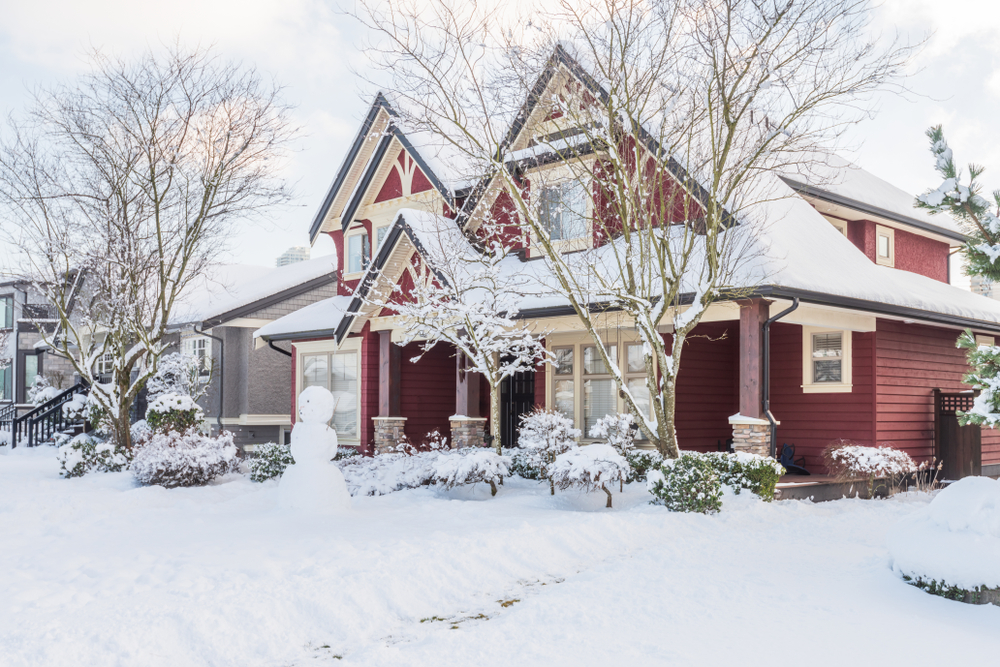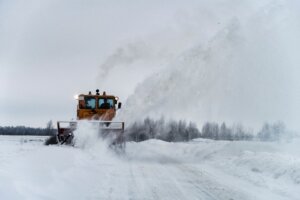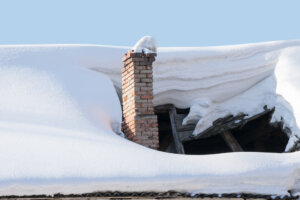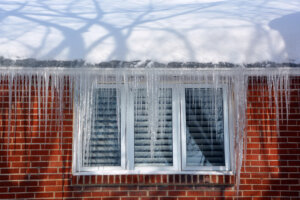Over the course of a long Canadian winter, the buildup of snow can create massive drifts alongside your home. While the snow may help to insulate you from sub-zero temperatures, it can also cause flooding when all that snow melts in early spring. It also poses other threats to your home and your personal safety. Here are all the ways snow buildup can damage your home (and how to avoid these issues altogether!)
1. Foundation Issues
Because concrete is porous, moisture can start to slowly seep into your home, making it incredibly important to plow or blow snow away from your foundation walls. As the water gets absorbed by concrete’s tiny pores, it freezes and expands slightly. These freeze/thaw cycles create small cracks that gradually increase in size every winter. This combined with a salt-based de-icer can gradually erode brick mortar, resulting in cracks that grow with each passing winter.
Shovelling your own snow presents several risks, especially if you live in an area that gets a lot of snow. It can lead to a variety of health issues including falls, backaches, and muscle fatigue. It’s better to hire a professional to remove snow after each snowfall.
While there are a number of different types of snow plowing contracts, they boil down to two broad types: 1) Fixed lump sum for the season regardless of amount and number of snowfalls that occur or 2) Variable amount for each snowfall, based on number of visits, depth of snow accumulation or time spent.
2. Icy Conditions
Ice on your sidewalk and driveway may cause accidents that send you, or someone walking by, to the hospital. While rock salt is cheap and effective, use it sparingly – it is hard on concrete, asphalt, and grass come springtime. Dogs also like to lick salt off their paws, which often makes them sick. Add traction to the surface by dispersing sandbox sand or fine gravel over the area. While sand will not melt the ice, it will provide improved grip underfoot.
Most snow removal companies will specify a minimum snowfall for them to come out, so when you get a light dusting of snow, keep a coarse-bristle push broom or light shovel handy to sweep it away. Even a light snow flurry can lead to ice, especially if temperatures are hovering near freezing when snow changes to rain or worse yet, freezing rain. This can create ‘black ice’ which you may not see until you slip on it!
3. Roof Damage
Damage
Snow will provide an extra layer of insulation to a well-built roof. But too much snow and ice can cause a roof to weaken or even collapse, in particular, flat roofs. Some municipalities may ask homeowners to remove snow from flat rooftops, overhangs and gutters, especially if the area has had heavy snowfall. But don’t risk damaging your roof or personal injury – removing snow from a roof is not a DIY project, it’s a job for snow removal professionals.
4. Ice Dams
Ice dams are another snow-related issue that can damage your home. If a roof is not well insulated, heat will come up through the roof’s surface and melt the snow resting on it. Direct sunlight on a south-facing roof also accelerates snow melting. The meltwater flows down the roof until it reaches a place that is below freezing – typically at the eaves where there is no heat from inside. When the meltwater reaches the frozen eavestrough, ice forms and accumulates, growing a dam or barrier that impedes the further passage of meltwater off the roof. Meltwater then backs up the roof and may cause water to leak into the attic through small roofing nail holes, resulting in damaged insulation, ceilings, walls and roof structure.
Once started, the dam continues to build in size and weight, also forming long and heavy icicles from the eaves. Serious injury can occur when the ice dam falls off suddenly or if someone attempts to remove it. If you need to remove snow from your roof or an ice dam from your eaves, call a roofing professional or an eavestrough specialist. Don’t risk damage to your building or injury to yourself or others.
Preventive Measures
As they say, an ounce of prevention is worth a pound of cure. So here a few steps to consider before the snow flies:
- Hire a snow removal company to remove your snow throughout the season. Sign a written contract that clearly defines their responsibilities and your expectations.
- Check the grade around your house to ensure it slopes down away from the foundation of your home. Get a landscaping company to improve your grading.
- Ensure downspout extensions carry water from the eavestroughs far away from the exterior walls, ideally two meters or more.
- Call a roofer or eavestrough specialist to check for damage from previous winters that should be repaired before the snow accumulates.
Use these suggestions to ensure you’re ready for that first blizzard when it comes. If you need help connecting with pros, simply click on the banner below. Enter your project details and we’ll send them out to Verified companies in your area who will get back to you with quotes. From there, you can book your service and never have to worry about snow damage to your home again.
Article updated November 20, 2019.




